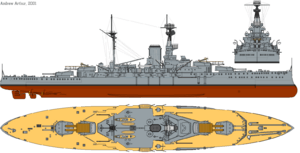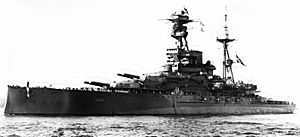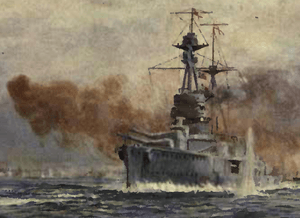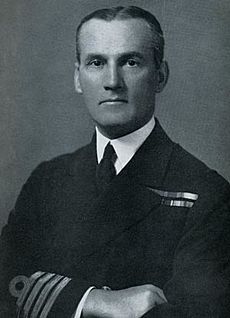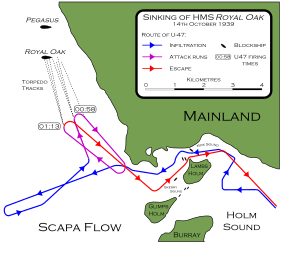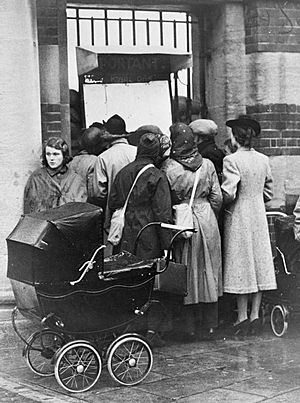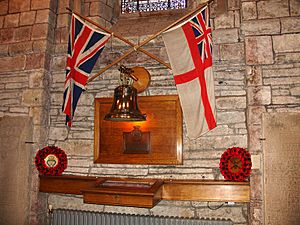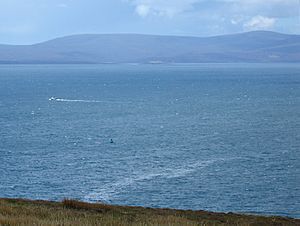HMS Royal Oak (08) facts for kids
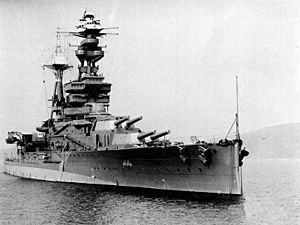
Royal Oak at anchor in 1937
|
|
Quick facts for kids History |
|
|---|---|
| Name | Royal Oak |
| Builder | Devonport Royal Dockyard |
| Cost | £2,468,269 |
| Laid down | 15 January 1914 |
| Launched | 17 November 1914 |
| Commissioned | 1 May 1916 |
| Identification | Pennant number: 08 |
| Nickname(s) | The Mighty Oak |
| Fate | Sunk by U-47, 14 October 1939 |
| Status | Protected war grave |
| General characteristics (as built) | |
| Class and type | Revenge-class battleship |
| Displacement | |
| Length | 620 ft 7 in (189.2 m) |
| Beam | 88 ft 6 in (27 m) |
| Draught | 33 ft 7 in (10.2 m) (Deep load) |
| Installed power | |
| Propulsion | 4 Shafts; 2 steam turbine sets |
| Speed | 22 knots (41 km/h; 25 mph) |
| Range | 7,000 nmi (12,960 km; 8,060 mi) at 10 knots (19 km/h; 12 mph) |
| Crew | 909 |
| Armament |
|
| Armour |
|
HMS Royal Oak was a powerful battleship built for the Royal Navy during World War I. She was one of five ships in her class, known as the Revenge-class battleship class. Launched in 1914 and finished in 1916, she first saw action in the famous Battle of Jutland.
After the war, Royal Oak served in different fleets around the world. She even made headlines in 1928 due to a big disagreement between her senior officers. This event caused a stir in the Royal Navy. Despite efforts to update her, Royal Oak was not very fast. By the start of World War II, she was no longer suitable for the main battle lines.
On 14 October 1939, while anchored at Scapa Flow in Scotland, Royal Oak was attacked by the German submarine U-47. Out of 1,234 crew members, 835 lost their lives. This included 134 young boy seamen under 18. The attack was a big shock, as Scapa Flow was thought to be very safe. It led to quick improvements in naval base security, including the building of the Churchill Barriers.
The wreck of Royal Oak lies upside down in about 100 feet of water. It is now a protected war grave. Every year, Royal Navy divers place a White Ensign flag on her stern to remember those lost. No one is allowed to dive on the wreck without special permission.
Contents
Design and Features of a Battleship
The Revenge-class ships, including Royal Oak, were designed to be strong battleships. They were a bit smaller and slower than the earlier Queen Elizabeth-class battleships, but had heavy armour for protection.
Size and Power
Royal Oak was about 620 feet 7 inches (189.2 m) long, which is longer than two football fields. She was 88 feet 6 inches (27 m) wide. The ship was powered by 18 large boilers that created steam for her engines. These engines gave her 40,000 horsepower, allowing her to reach a top speed of about 22 knots (40.7 km/h; 25.3 mph) (around 25 miles per hour). She could travel about 7,000 nautical miles (12,964 km; 8,055 mi) (about 8,000 miles) at a slower speed. In 1916, her crew had 909 officers and sailors.
Weapons and Protection
Royal Oak had eight powerful 15-inch guns in four twin turrets. These were her main weapons. She also had fourteen 6-inch guns for smaller targets. For air defence, she had 3-inch anti-aircraft (AA) guns. The ship also carried four 21-inch torpedo tubes.
Her armour was very thick to protect against enemy attacks. The main belt armour along her waterline was 13 inches (330 mm) thick. Her gun turrets had armour up to 13 inches (330 mm) thick. The decks were also armoured, ranging from 1 to 4 inches (25 to 102 mm) thick. After the Battle of Jutland, extra steel was added to protect the ammunition storage areas.
Ship Upgrades
Over the years, Royal Oak received several upgrades. Between 1922 and 1924, her anti-aircraft guns were improved. She also got anti-torpedo bulges, which were extra sections added to her sides. These bulges helped protect her from torpedoes and made her more stable. However, they also made the ship wider and a bit slower.
In her final major refit from 1934 to 1936, her deck armour was made even thicker. Her anti-aircraft defences were greatly improved with new, more modern guns. She also received new equipment to help aim her guns better. These changes made her more ready for modern warfare, but she remained a relatively slow ship.
Royal Oak in Service
Royal Oak was built at Devonport Royal Dockyard and cost over £2.4 million. She was named after the Royal Oak tree where King Charles II hid. She was the eighth Royal Navy ship to carry this name.
First World War
Battle of Jutland
Royal Oak first saw battle at the Battle of Jutland in May 1916. This was a huge naval battle between the British Grand Fleet and the German High Seas Fleet.
On 31 May, Royal Oak fired her main guns at the German cruiser SMS Wiesbaden, hitting it. Later, she also fired at German battlecruisers like SMS Derfflinger and SMS Seydlitz. She was not seriously damaged during the battle. After hours of fighting, both fleets pulled back. Royal Oak fired 38 large shells and 84 smaller shells during the battle.
Later Actions and Incidents
After Jutland, Royal Oak continued to serve. In late 1917, she helped protect British convoys (groups of ships) sailing to Norway from German attacks.
On 5 November 1918, just before the end of World War I, Royal Oak was involved in an accident. A strong storm caused the seaplane tender Campania to hit Royal Oak and then another ship, Glorious. Campania was badly damaged and sank, but thankfully no lives were lost.
After Germany surrendered, most of their fleet was taken to Scapa Flow. On 21 June 1919, the German commander ordered his ships to be sunk to prevent the British from taking them. Royal Oak was present during this event.
Between the World Wars
In the 1920s, Royal Oak was part of the Atlantic Fleet and later the Mediterranean Fleet.
The "Royal Oak Mutiny" Incident
In 1928, a famous incident happened on Royal Oak, which the newspapers called the "Royal Oak Mutiny". It started as a small argument between Rear-Admiral Bernard Collard and the ship's captain, Kenneth Dewar, and Commander Henry Daniel. This argument grew into a serious personal feud.
Dewar and Daniel complained about Collard's behaviour. In response, Collard accused them of not following orders. The situation became so bad that all three officers were sent back to England. This caused a lot of talk and was reported by newspapers worldwide.
Dewar and Daniel faced court-martials, where they were found guilty of writing "subversive documents". They were punished, and Daniel left the Navy. Collard was also criticized and had to retire. This event was embarrassing for the Royal Navy and led to changes in how officers could complain about their superiors.
1930s Service
During the Spanish Civil War, Royal Oak helped with patrols to prevent outside countries from getting involved. In February 1937, she was accidentally attacked by Republican aircraft, but suffered no damage. Later that month, she was hit by an anti-aircraft shell fired by Republican forces, injuring five men, including her captain.
In May 1937, Royal Oak helped escort a ship carrying Basque child refugees to England. She also tried to protect British merchant ships during the war.
Royal Oak even appeared in a 1937 British film called Our Fighting Navy. She played a rebel battleship in the movie.
In 1938, Royal Oak became the flagship of the Second Battle Squadron. In November 1938, she carried the body of Queen Maud of Norway (who was born in Britain) back to Oslo for her funeral. After a final refit, she was sent north to Scapa Flow when World War II began in September 1939.
Second World War
At the start of World War II, Royal Oak was involved in searching for German warships. However, her slow speed (less than 20 knots (37 km/h; 23 mph)) made it hard for her to keep up. By October 1939, she was in poor condition after being battered by storms. She returned to Scapa Flow, where her anti-aircraft guns were still considered useful for the base's air defences.
The Sinking of Royal Oak
Scapa Flow is a large, natural harbour in the Orkney Islands, Scotland. It was a very important naval base for the British during both World Wars. The harbour is surrounded by islands, with narrow, shallow channels between them. These channels had defences like sunken ships (blockships) and floating barriers to stop enemy submarines. It was thought to be very safe.
The U-47 Raid
The German submarine commander, Karl Dönitz, planned a secret attack on Scapa Flow. He chose Günther Prien, a skilled submarine captain, for the mission. The raid was set for the night of 13/14 October 1939, when the tides were high and the night was dark.
Prien's submarine, U-47, entered Scapa Flow through a difficult eastern channel called Kirk Sound. He had to navigate carefully between sunken blockships. At one point, the submarine briefly touched a cable, but no alarm was raised. Prien was surprised to find the harbour almost empty, as many British ships had left.
At 12:58 AM on 14 October, U-47 spotted Royal Oak. Prien fired three torpedoes. One hit Royal Oak at 1:04 AM, causing a shake but little visible damage. Many sailors thought it was an internal explosion and went back to their beds.
Prien turned his submarine and fired again. At 1:16 AM, all three torpedoes hit Royal Oak in quick succession. The explosions blew a large hole in the ship. Fire spread quickly inside. Royal Oak immediately began to list (tilt) to one side. She rolled over to 45 degrees and then sank completely at 1:29 AM, just 13 minutes after the second attack.
Rescue Efforts
The tender ship Daisy 2, captained by John Gatt, was tied to Royal Oak. As Royal Oak began to sink, Gatt quickly cut his boat free.
Many of Royal Oak's crew jumped into the freezing water. The surface was covered in thick fuel oil, making it hard to swim and breathe. Only a few managed to swim to shore.
John Gatt and his crew on Daisy 2 worked tirelessly. They managed to pull 386 men from the water, including Royal Oak's captain, William Benn. Gatt was awarded the Distinguished Service Cross for his brave actions. In total, 424 men survived the sinking.
Aftermath of the Sinking
The British were initially unsure what caused the sinking. Once they realized it was a submarine attack, they tried to seal the harbour, but U-47 had already escaped. The BBC announced the news on 14 October.
The German government used the successful raid for propaganda. Prien and his crew were welcomed as heroes in Germany. Prien was given the Knight's Cross of the Iron Cross, a very high award. He became known as "The Bull of Scapa Flow".
The British Admiralty (the navy's leadership) investigated the disaster. They found that the defences at Scapa Flow were not ready. Winston Churchill, the First Lord of the Admiralty, announced the loss to Parliament. He also had to explain why so many young boys were on board. After this, the Royal Navy generally stopped sending boys under 18 to active warships.
Churchill Barriers
To prevent future attacks, Winston Churchill ordered the construction of concrete causeways. These barriers linked several islands around Scapa Flow, closing off the eastern entrances. Built mostly by Italian prisoners of war, these Churchill Barriers were finished by 1944 and officially opened in 1945.
Survivors and Legacy
The survivors of Royal Oak were housed in Orkney. A funeral parade was held for the dead on 16 October. Many survivors had lost everything and wore borrowed clothes.
Captain Prien and U-47 were lost in March 1941. Some of U-47's crew members who survived the war later met with Royal Oak survivors and became friends.
The HMS Royal Oak Association holds a memorial service every year in Portsmouth to remember those who died. In 2019, a memorial stone was unveiled by Anne, Princess Royal.
The Wreck of Royal Oak
War Grave Status
Most of the bodies from Royal Oak could not be recovered. The wreck is marked by a buoy and is a designated war grave. This means that diving on the wreck or exploring it without permission is against the law. In clear water, you can see the upturned hull of the ship just 5 metres (16 ft) (about 16 feet) below the surface.
The ship's bell was recovered in the 1970s. After being cleaned, it was placed in the St Magnus Cathedral in Kirkwall as part of a memorial. A book of remembrance lists the names of those who died.
Environmental Concerns
When Royal Oak sank, she had about 3,000 tons of fuel oil on board. Over the years, this oil has slowly leaked from the wreck. This raised concerns about pollution in Scapa Flow.
Because Royal Oak is a war grave, any work on the wreck must be done very carefully. Plans to raise the ship in the 1950s were stopped due to public opposition. Removing the oil is difficult because it could damage the wreck or release all the oil at once. There are also many unexploded bombs still inside the ship.
Since 2006, efforts have been made to pump the oil out of the wreck. By 2010, 1,600 tons of fuel oil had been removed. The wreck is no longer actively leaking oil, but some oil still remains inside.
2019 Survey
In 2018, a team of diving experts began surveying the wreck of Royal Oak. They used special cameras and technology to create a 3D image of the war grave. This survey had the full support of the Royal Navy and the Royal Oak Association.
Images for kids
-
Royal Oak returns the body of Queen Maud to Norway, flying both the Norwegian flag and the White Ensign at half-mast, about 24 November 1938.
See also
 In Spanish: HMS Royal Oak (08) para niños
In Spanish: HMS Royal Oak (08) para niños


